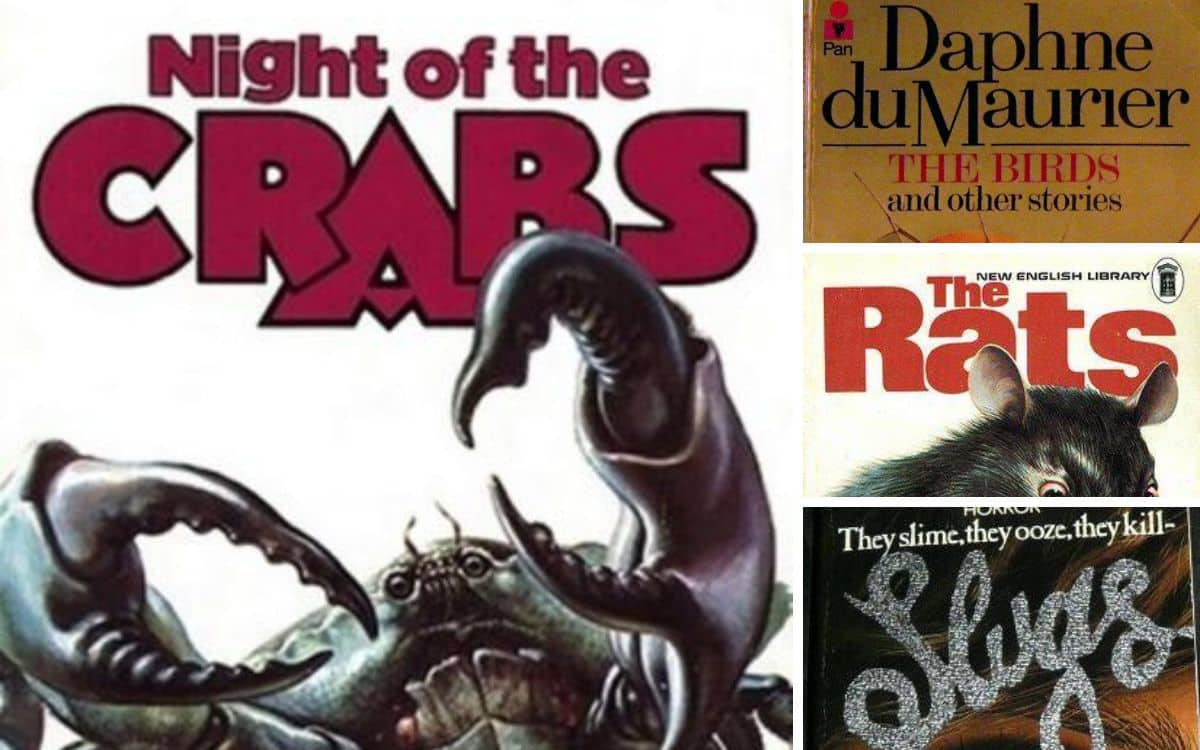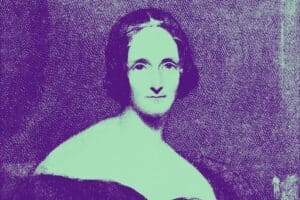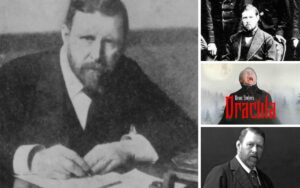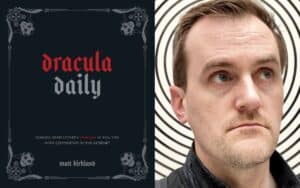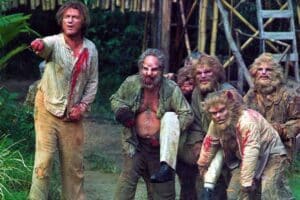British literature has long been fascinated by the concept of animals turning violently against humans. DAVID TURNBULL looks at The Birds and similar animal horror stories.
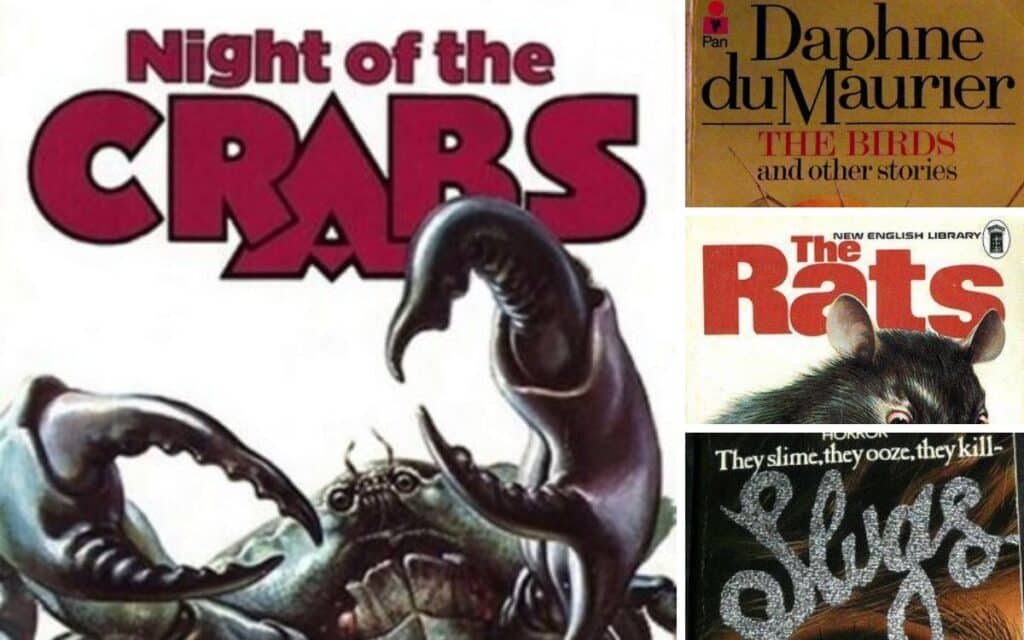
Sixty years ago, in 1963, cinema goers gripped the armrests of their seats as the birds in Alfred Hitchcock’s horror thriller of the same name became inexplicably blood thirsty predators, attacking Rod Taylor, Tippi Hedren and the inhabitants of the Californian coastal resort of Bodega Bay. The film was highly acclaimed and is today rightfully considered a horror movie classic.
However, the original 1952 short story by Daphne du Maurier was not located anywhere near the west coast of America, but on the south coast of England. Cornwall to be precise.
The Birds (1952)
The main character, Nat Hocken, is a World War II veteran, who can only work a few days a week at a local farm due to injuries received in combat. He lives with his family in a rural area near the Cornish coast, the part of the country du Maurier herself grew up in. Whereas in the Hitchcock movie the savage behaviour of the birds remains largely unexplained, the original story hints that this may be connected to atmospheric conditions and the movements of the tides.
It has been suggested that du Maurier was inspired to write The Birds when reflecting on the feelings of helplessness the British populace experienced during the blitz and Battle of Britain. A time when death could rain down from the sky at any minute. Seeing a fisherman being harassed by a large seagull gave her the idea of making the assailants those of the feathered variety rather than the bombers and fighter planes of Hitler’s Luftwaffe.
In the story Hocken and his family witness and directly experience the savage attacks of the birds, while at the same time listening to BBC radio reports of similar incidents occurring across the length and breadth of the British Isles. The Hitchcock movie ends with the hint of a possible escape as the lead characters leave the house in which they have been besieged and pass cautiously through hordes of temporarily docile birds. Du Maurier’s story ends less optimistically.
Nat Hocken and his family are locked inside their cottage. Birds of all shapes and sizes are trying to splinter the timbers of their front door. Hocken smokes a last cigarette and tosses the empty pack absently onto the dying embers of their fireplace. What happens next is left to the imagination.
Food of the Gods and How It Came To Earth (1904)
Du Maurier was not the first author to depict members of the animal kingdom turning on mankind. Science fiction pioneer HG Wells’ novel The Food of the Gods and How It Came to Earth was published in 1904. The novel begins on a farm near the fictional Kentish town of Urshot. Here scientists have developed a substance known as Herakleophorbia IV (the food of the Gods) which can cause unnatural growth in any creature which eats it. They feed it to chickens which grow to six times their normal size.
Unfortunately, as is often the way with scientific experiments in such novels, the scientists fail in their efforts to contain the food of the Gods on the farm. Once it enters the local food chain nearby villagers are subjected to attacks by gigantic wasps and earwigs. In classic horror story style, the villagers revolt and burn the farm to the ground. But it is too late. By then oversized creatures are appearing all over the country and children are being fed what is now called Boomfood to encourage growth. The story culminates with a civil war between normal sized people and the forty-foot tall offspring.
Food of the Gods was made into a 1977 movie with South London born Ida Lupino playing a farmer’s wife who feeds a strange substance that has fallen from outer space to her chickens which then grow to gigantic size. In the same year there was a comic book adaptation of the story in the Marvel Classics series.
Doctor Who: Planet of the Giants 1964
Planet of the Giants, the 1964 opening storyline of the second series of Doctor Who, has the Tardis materialising rural England where William Hartnell as the Doctor, along with his companions, encounter the dead bodies of gigantic ants and beetles. On this occasion it is not the insects which have become gigantic but a malfunction in the Tardis which has shrunk them to one inch tall. The plot has a highly contemporary theme, involving a callous industrialist who has developed a potent insecticide called DN6, which could potentially wipe out all of the insect life on the planet.
Colin Wilson’s Spider World series of science fantasy novels, which started with Spider World – The Tower in 1987, depicts a 25th century where the UK and the rest of the world is dominated by gigantic spiders who have enslaved mankind.
But it is the pulp horror fiction of the late 70s and early 80s that picked up where Daphne du Maurier left off in the early 50s and turned the concept of the animal world turning violently against humanity into a whole sub-genre of its own.
The Rats (1964) and other pulp horror
Probably the best known of the pack is The Rats by James Herbert. First published in 1974 the story is set in the, then delipidated and run down, docklands area of London, nowadays dominated by the skyscrapers of Canary Wharf. The plot centres on oversized mutated rats which can manipulate normal sized rats into attacking humans using a form of telepathic ultrasound. Carnage and mayhem ensue as the rats attack their human prey at a tube station, a cinema, a school and London Zoo.
Although ultimately defeated the rats returned, in Epping Forest this time, for the sequel Lair (1979) in which the mutated two headed rat born in a litter at the end of The Rats leads her horde in a series of new grisly attacks, and then again in Domain (1984) and The City (1993), also released as a graphic novel, where the rats have become the dominant species in the ruins of a London devastated by a nuclear attack.
In 1977 it was the turn of fluffy domestic cats to go on the rampage. The Cats by Nick Sharman is set in London’s Paddington during a heatwave. Here an American scientist has been experimenting on cats with a bacterium he plans to develop as a biological weapon. Once exposed, normally docile felines are transformed into vicious killers, who, as depicted later in the novel, can easily take down a foe as formidable as a Dobermann Pinscher. When a young schoolboy hired by the scientist to look after these experimental cats unwittingly releases them onto the sun-baked London streets all hell breaks loose.
The Cats had been preceded a year earlier by Guy N Smith’s Night of the Crabs which takes place on a Welsh coastline plagued by an clacking infestation of killer crabs. The novel spawned no less than six sequels, including Killer Crabs and Crabs on the Rampage, moving the action to locations such Loch Ness and the Great Barrier Reef before returning to the Welsh coast for its culmination.
Slugs (1982)
In 1982 it was the turn of slugs to take centre stage. In Slugs written by Shaun Hutson these bloodthirsty mutations come oozing out of basements and up through floorboards in the fictional English town of Merton to feast upon their human victims. Ultimately a poison is developed which can kill the slugs. However, the novel ends with a consignment of lettuce containing infected slug eggs being delivered to London’s Covent Garden fruit and veg market, setting the scene for the 1985 sequel Breeding Ground. Slugs was made into a Spanish produced horror movie, Slugs, Muerte Viscosa, in 1988, but a planned movie version of Breeding Ground never came to fruition.
All of this led to a biblical plague of similar fare, with all sorts of animal and insect related horror novels infesting the shelves of bookshops and libraries up and down the land. Pigs in The Farm and its follow up The City by Richard Haigh. Rabbits in The Folly by David Anne and dogs in Day of the Mad Dogs by the same author. All sort of slithering slimy creatures came out of the sewers and the sea in John Halkin’s gruesome trilogy Slither, Slime and Squelch.
70s kid’s comics even got in on the act. Von Hoffman’s Invasion by Tom Tully and Eric Bradbury appeared first in Jet and then continued in Buster. Von Hoffman is a mad Nazi scientist who, in the first story of the series, has been locked up for twenty-five years as a war criminal. On release he is determined to take revenge on the British for Hitler’s defeat. Armed with an umbrella which deploys a gas which can instantly turn creatures into giants he embarks on a one man invasion. As he progresses toward London the residents of southern England are subject to all sorts of attacks from his gas induced monstrosities – wasps, woodlice and woodworm to name but three.
Animal horror today
Today the notion of the animal world turning on humanity lives on, with the subject often being the central theme of short story horror anthologies released by UK independent small press publishers.
Shadow Publishing’s 2015 Creeping Crawlers, edited by Allen Ashley, ominously predicts that ‘the maggots, the worms, the flies, the aphids and the termites may destroy and consume all that we have and hold dear’. While Arachnofright (Gravestone Press) edited by Dorothy Davies brings our scuttling eight legged goes to the fore.
Recently Dublin based author, Rachel Handley, has announced the launch of a magazine called Crab Tales, which she promises will be dedicated to short horror and Sci-Fi fiction about creepy crustaceans.
Had he been alive today I feel sure Guy N. Smith would be over the moon to hear of this development.
Tell us your thoughts on this articles in the comments section below!

